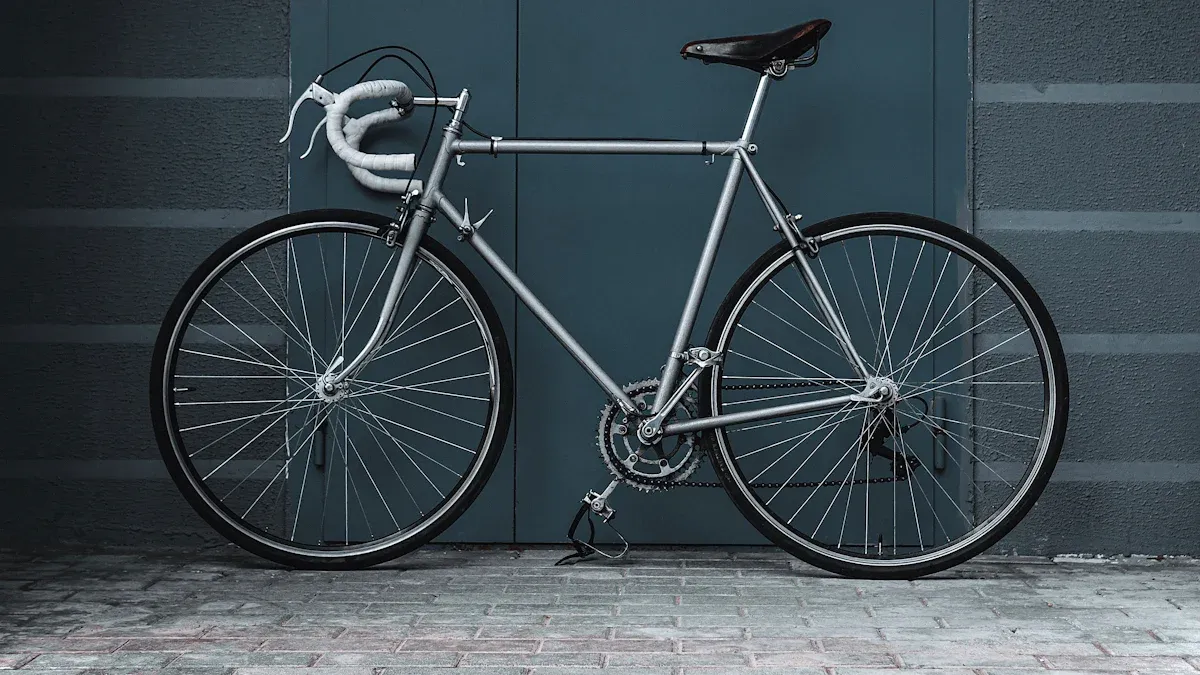
Mountain biking is getting very popular! In 2023, the worldwide mountain bike market reached about $12.43 billion. It is expected to rise to $26.28 billion by 2032. More than 9.2 million Americans are riding on trails. The type of frame material is very important now. You should think about how weight, strength, ride quality, cost, and upkeep can affect your time on steel frame trail bikes compared to aluminum.
Key Takeaways
Aluminum frames are lighter. This helps with speed and quick turns on trails.
Steel frames are stronger. They give a smoother ride, which is great for bumpy paths and long rides.
Think about how you ride: pick aluminum for speed and quickness, or steel for comfort and toughness.
Weight Comparison

Weight is very important for mountain biking. Steel frames usually weigh more than aluminum ones. On average, an aluminum bike weighs about 19 pounds. A steel bike weighs around 21 pounds. That’s a difference of about 2 pounds. This may not seem like a lot, but it can change how you ride on the trails.
Handling Differences
The weight of your bike affects how it handles. Lighter frames, like aluminum, make it easier to move. You will notice faster acceleration and better control, especially on tough trails. Here are some important points to think about:
Maneuverability: A lighter bike helps you turn and avoid obstacles easily.
Acceleration: Lighter materials help you go faster, which is important for steep hills.
Rotational Mass: Lighter frames lower the rotational mass. This improves your bike’s speed and braking. It helps keep your momentum on steep paths.
Performance Impact
The weight of your bike also affects how well it performs. Here’s how different factors are changed by the frame material:
Performance Metric | Influence of Frame Material |
|---|---|
Weight | Lighter materials like aluminum lower bike weight, helping with speed and climbing. |
Stiffness | Affects how well power transfers; stiffer frames waste less energy. |
Durability | Makes sure the bike can handle rough rides and different terrains. |
Vibration Damping | Increases comfort and reduces tiredness on long rides and bumpy paths. |
Choosing the right frame material can change your riding experience a lot. If you want speed and quick moves, an aluminum frame is a good choice. But if you want strength and a smoother ride, a steel frame might be better. Knowing how weight affects handling and performance will help you decide wisely.
Durability: Steel vs Aluminum

When we talk about durability, steel frames are really strong and last a long time. Steel-framed bikes can handle rough trails and tough conditions better than aluminum bikes. This strength lets you ride confidently, knowing your bike won’t easily get damaged.
Strength and Longevity
Steel frames are great at resisting wear and tear. They can take repeated stress and vibrations without cracking. In fact, steel is about 50% better than aluminum at handling fatigue. This makes steel a smart choice for tough rides, especially if you often ride challenging trails.
Aluminum frames are light and strong, but they have weak spots. The welds are especially vulnerable. After a big hit, check these areas for cracks. If you don’t, you could have serious problems later. Here are some common reasons aluminum frames fail:
Manufacturing mistakes can create stress points.
Weak areas, like the derailleur hanger, can get damaged easily.
Resistance to Damage
Both materials have good and bad sides when it comes to damage. Steel frames can rust and corrode over time, especially in wet or salty places. This can cause problems if you don’t take care of them. But with regular maintenance, your steel bike can last for years.
Aluminum frames usually resist impact damage better. They handle crashes well compared to many other materials. However, they can lose stiffness over time, which can affect how they perform. Here’s a quick comparison of common damage types:
Material | Common Damage | Notes |
|---|---|---|
Steel | Rust and corrosion | Can deteriorate if not maintained |
Aluminum | Wear over time, weld cracks | Harder to repair, weak at welds |
Ride Quality: Steel Frame Trail Bike
The material of your bike frame is very important for ride quality. Steel frame trail bikes are great at absorbing bumps and vibrations. This makes your ride smoother, especially on long trails. Many riders like steel frames for long rides because they help reduce tiredness. Here’s what riders often say:
Steel frames handle small bumps well.
Aluminum frames can feel stiff, making rides rougher.
The bike’s design, like tire choice and suspension, also affects comfort a lot.
Vibration Damping
Steel frames usually flex more than aluminum ones. This flex helps to absorb vibrations, making your ride nicer. Research shows that the frame material matters less for comfort when you think about other parts like tires and seat padding. Still, steel’s natural qualities help it absorb shocks better.
Comfort and Handling
Handling and control are very important on tricky trails. Here’s a quick look at how different frame materials compare:
Frame Material | Handling Characteristics | Control Characteristics |
|---|---|---|
Carbon | Can be too stiff or too flexible based on design | May feel hard to control when bending |
Aluminum | Some internal friction helps reduce spring back | More controlled flex due to hysteresis |
Steel | Generally more flexible because of smaller tubes | Often feels more comfortable because of flex |
With a steel frame trail bike, you will likely find that the extra comfort helps with handling. The flex lets you move smoothly over obstacles, giving you more confidence on tough trails. So, if you care about comfort and handling, a steel frame might be just right for your riding style.
Cost Considerations
When you pick between steel and aluminum frame trail bikes, cost matters a lot. Let’s look at the price range first.
Price Range
Steel frame bikes usually cost more than aluminum ones. For example, the Marin Pine Mountain 2, which is steel, costs about $2,399. In contrast, the Canyon Stoic 4, an aluminum bike, is priced at $1,699. Here’s a quick comparison:
Frame Material | Model | Price |
|---|---|---|
Steel | Marin Pine Mountain 2 | $2,399 |
Aluminum | Canyon Stoic 4 | $1,699 |
Value for Money
Now, let’s discuss value for money. You want to make sure your investment is worth it in durability and performance. Here’s how the two materials compare:
Factor | Steel Frame | Aluminum Frame |
|---|---|---|
Cost | Usually more affordable | Often less expensive |
Durability | Moderate durability | |
Comfort | Provides great comfort | Can be less comfortable |
Ride Quality | Gives a smooth ride | May feel stiffer |
Steel frames often last longer because they are durable. They bend instead of cracking, so they can handle rough rides without damage. Aluminum bikes are lighter but can crack quickly, leading to expensive repairs.
In the end, if you want a bike that lasts and is comfortable, a steel frame might be worth the extra cost. But if you prefer something lighter and cheaper, aluminum bikes could be the better choice.
Maintenance Needs
Taking care of your bike is crucial for keeping it in top shape. Each frame material has its own maintenance needs, so let’s break it down.
Care for Steel Frames
Steel frames require special attention to prevent rust. Here are some key care tips:
Regular Inspections: Check for early signs of rust. Catching it early can save you from bigger issues later.
Cleaning After Rides: Always clean your bike after wet rides. This helps prevent moisture buildup that can lead to rust.
Rust Prevention: Use rust-resistant sprays and coatings. These protective measures are essential for maintaining your steel frame’s integrity.
To keep your steel bike in great condition, follow these steps:
Ensure small threads are well greased to prevent rust.
Remove all parts at the end of the riding season to apply rust inhibitors and grease components.
Use Frame Saver to protect the inside of the frame from moisture.
Care for Aluminum Frames
Aluminum frames are less prone to rust but still need care to prevent corrosion. Here’s how you can maintain your aluminum bike:
Regular Cleaning: Clean your bike periodically to prevent corrosion. A clean bike is a happy bike!
Use Protective Products: After cleaning, apply a 3M #7447 Scotch-Brite™ pad with Fluid Film. This helps protect the surface.
Seal and Protect: Use Nu-Finish car polish with a finer Scotch-Brite™ #7445 pad to seal and protect the aluminum.
Also, remember to keep your bike clean and dry. After riding in rain or mud, give it a good wash. Storing your bike with an anti-rust cover can also help protect it from harsh elements.
By following these maintenance tips, you can ensure your bike stays in great shape, whether it’s steel or aluminum!
Choosing between steel and aluminum bike frames can be confusing, but knowing the differences helps a lot. Here’s a quick summary:
Weight: Aluminum is lighter, which is good for speed.
Durability: Steel lasts longer and handles rough trails better.
Ride Quality: Steel gives a smoother ride, while aluminum feels stiffer.
Cost: Steel frames usually cost more but are better in the long run.
Maintenance: Steel needs rust protection, while aluminum needs care to stop corrosion.
Think about your riding style and the trails you ride on when making your choice. Whether you prefer the strength of steel or the lightness of aluminum, understanding these points will help you decide on the bike frame.
Weight | Durability | Ride Quality | Best For | |
|---|---|---|---|---|
Aluminum | Lightweight | Moderate | Good | Commuting, Road Biking |
Steel | Heavier | High | Moderate | Touring, Commuting |
Chromoly Steel | Lightweight | High | Good | Performance Road Biking |
Carbon Fiber | Very Light | High | Excellent | High-End Mountain, Road |
Titanium | Lightweight | Very High | Excellent | Premium Bikes |
FAQ
What are the main benefits of aluminum vs steel frames?
Aluminum frames are lighter and usually cost less. Steel frames are stronger and provide a smoother ride, which is good for rough trails.
How do I choose between aluminum vs steel for my riding style?
Think about what matters most to you. If you want speed and quick moves, choose aluminum. If you want comfort and strength, go with steel.
Are aluminum vs steel bikes more expensive?
Steel bikes often cost more because they are durable and well-made. But aluminum bikes can be cheaper at first.
See Also
Understanding The Differences Between Bike Frame Materials
Key Differences Between Triathlon And Time Trial Bike Frames
How Track Bike Frames Differ From Standard Bike Frames
